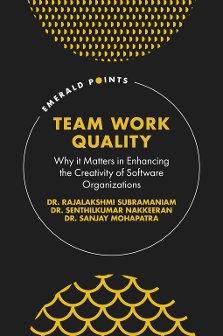
Index
Rajalakshmi Subramaniam
(Talaash Research Consultants Private Limited, India)
Senthilkumar Nakkeeran
(Anna University, India)
Sanjay Mohapatra
(Xavier Institute of Management, India)
This content is currently only available as a PDF
Citation
Subramaniam, R., Nakkeeran, S. and Mohapatra, S. (2021), "Index", Team Work Quality, Emerald Publishing Limited, Leeds, pp. 127-129. https://doi.org/10.1108/978-1-80117-262-220211008
Publisher
:Emerald Publishing Limited
Copyright © 2021 Rajalakshmi Subramaniam, Senthilkumar Nakkeeran and Sanjay Mohapatra. Published under exclusive licence by Emerald Publishing Limited
INDEX
American Psychological Association (APA)
, 13, 56
Analysis of co-variance (ANCOVA)
, 47–48, 79
core activity
, 50
creativity
, 48
ethnic diversity
, 49
team age
, 48
team leader
, 50
team size
, 48
Analysis of variance (ANOVA)
, 44, 78–79
creativity
, 47
ethnic diversity
, 46
team age results
, 45
team’s core activity
, 46
team size
, 45
tenure of team leader
, 47
Atmosphere for work (ATW)
, 27, 86
Attitude to work (AW)
, 27
Capability Maturity Model Integration (CMMI)
, 70
Chi-square test
, 36, 43, 79
Cluster sampling
, 71–72
CMMI DEV V1.3 assessment
, 70–71, 86
Collection technique
, 72
Communication
, 96
Componential model
, 13, 56
Conceptual model
, 61–64
Core activity distribution
, 20–21
Correlations
, 24–27, 29
Cox’s R-squared
, 28
Creative behaviour (CB)
, 27, 86
Creative Climate Questionnaire (CCQ)
, 73–74
Creative work climate (CWC)
, 9, 40
chi-square
, 42–44
cross tabulation
, 42–44
odds ratio
, 42–44
vs. organizational creativity
, 15
Creativity
, 5–6, 40–41, 55, 61, 73–74, 85, 89–90, 96
concept
, 13–15
organizational
, 6–7
Data analysis
, 75–80
Data type
, 72
Deductive approach
, 69
Demographic profile
, 88
Department of Industrial Policy and Promotion (DIPP)
, 2
Dependent variable (DV)
, 73
Descriptive statistics
, 18
Ethnic diversity
, 45–46, 63
Foreign direct investment (FDI)
, 2
F-statistic
, 44
Gender
, 20, 22, 88
pie chart
, 22
Graphical method
, 77
Human resources
, 5
Hypotheses
, 61, 64, 67–68, 87
Indian software organization
communication skills
, 2–3
creativity
, 62, 92–93
development
, 1
export value
, 1
growth life cycle
, 1
market size
, 2
team work quality (TWQ)
, 62, 92
Individual creative behaviour
, 9, 73–74
vs. organizational creativity
, 14–15
Innovation
, 5–6
Interactionist model
, 13–14, 56, 73–74
Logistic regression
, 24, 78
Management practices (MP)
, 27
Members background
, 20–21
Mutual support (MS)
, 24
National Association of Software and Service Companies (NASSCOM)
, 2
Organizational creativity
, 6–7, 9, 56, 73–74, 89
vs. creative work climate
, 15
vs. individual creative behaviour
, 14–15
interactionist model
, 14
Organizational motivation (OM)
, 27, 86
Pearson correlation test
, 77–78
Principal component analysis (PCA)
, 24, 78
Problem definition
, 65–66
Questionnaires
, 98–109
Relationship research
, 69–70
Research gap analysis
, 58–60
Research instrument design
, 73–74
Research methodology
aim
, 66
collection technique
, 72, 82
data type
, 72
deductive approach
, 69
design
, 69–70
epistemology
, 68
ethical considerations
, 81
extension
, 94
hypotheses definition
, 67–68
instrument design
, 73–74
limitations
, 93
methodology
, 68, 82
objectives
, 66–67
ontology
, 68
pilot testing
, 75
problem definition
, 65–66
research questions (RQs)
, 67
sampling
, 70–72
statistical and software tools
, 75–80
techniques
, 80–81
theoretical and managerial implications
, 91
theoretical constructs
, 67–68
Research questions (RQs)
, 67
Respondent’s age
, 21–23
Sampling design
, 70–72
Self-efficacy
, 5
Simple percentage analysis
, 77
Socio-demographic data
, 17
age group distribution
, 21, 23
communalities
, 32–33
core activity distribution
, 20–21
correlations
, 24–27, 29
descriptive statistics
, 18
education
, 23
gender
, 20, 22
hypotheses
, 36–53
members background
, 20–21
omnibus test of model coefficients
, 28, 30
principal components
, 34
respondent’s age
, 21–23
scree plot
, 35–36
team age
, 19
team leader
, 19–20
team role
, 20–21
team size
, 18–19
total variability
, 32–33
variables
, 30–31
work experience
, 23–24
Software Engineering Institute (SEI)
, 70
Software organizations
organizational creativity
, 6–7
team work
, 3–4
Software quality
, 11, 55–56
Software tools
, 80
Statistical techniques
, 76–80
analysis of co-variance (ANCOVA)
, 79
analysis of variance (ANOVA)
, 78–79
chi-square test
, 79
graphical method
, 77
logistic regression
, 78
Pearson correlation test
, 77–78
principal component analysis (PCA)
, 78
simple percentage analysis
, 77
student’s T-test
, 80
Student’s T-test
, 80, 90–91
Team age
, 9, 19, 44, 63
pie chart
, 20
Team characteristics
, 44, 51, 55, 61
moderating effects
, 90
vs. team performance
, 89
Team cohesion (COH)
, 24
Team coordination of expertise (COE)
, 24
Team ethnic diversity
, 10
Team leader
, 10, 19–20
Team performance (TP)
, 24, 89
Team role
, 10, 20–21, 45, 63, 88
Team size
, 63, 97
bar graph
, 19
defined
, 9
Team work quality (TWQ)
, 3–4, 7–8, 55, 61, 85, 89–90
chi-square
, 36–40
components
, 24
concept
, 12
cross tabulation
, 36–40
dimensions of
, 12
odds ratio
, 36–40
research methodology
, 65–68
result comparison
, 90–91
socio-demographic data
, 17–53
t-Tests
, 51–52
Trust (TR)
, 24
Value diversity (VD)
, 24, 96
- Prelims
- 1 Introduction
- 2 Team Work Quality
- 3 Evolution of Creativity
- 4 Importance of Team Characteristics in Determining Team Performance
- 5 Conceptual Model Associating TWQ, Creativity and Team Characteristics
- 6 Research Methodology Employed
- 7 Strategies for Indian Software Organizations for the Enhancement of Team Work Quality and Organizational Creativity
- References
- Index